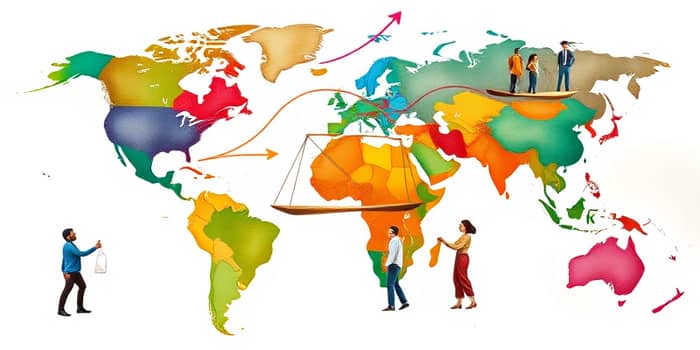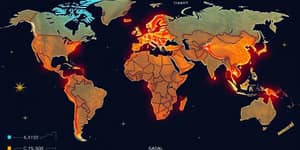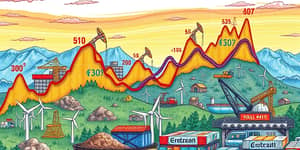
As global economies navigate the evolving landscape of price pressures in 2025, understanding regional differences and strategies becomes crucial. This article explores key trends, policy responses, and practical approaches adopted by nations to manage inflation effectively.
By early 2025, developed and emerging economies exhibit a broad spectrum of inflation rates. The OECD reports headline inflation at 4.0% year-on-year in January, while G7 inflation holds steady at 2.9%. G20 figures average 5.0% but mask extremes—from Argentina’s above 80% to China’s subdued 0.5%. Central banks that hiked rates aggressively in 2022–23 have since pivoted toward gradual monetary policy easing, with further rate cuts expected through 2026.
Energy markets have played a pivotal role: a moderation in oil and gas prices has alleviated headline pressures in Europe and North America. Simultaneously, food price fluctuations continue shaping inflation dynamics in the UK and Japan, underscoring the importance of sectoral analysis.
In the United States, headline inflation stabilized in late 2024, while regional CPI forecasts edge toward the low-to-mid 3% range by year’s end. The Northeast records a 2.8% rise in May 2025, with core CPI at 3.1%.
Key drivers include renewed price pressures from tariffs, tight labor market conditions, and persistent shelter cost increases. The Federal Reserve began cutting rates in late 2024 and signals further reductions, aiming to support growth without reigniting inflation.
Canada’s inflation slowed to 1.7% in April 2025 after peaking higher in prior years. The Bank of Canada has mirrored the Fed’s approach, reversing earlier hikes and embracing rate cuts to sustain economic momentum.
The euro area’s inflation fell to 2.4% in February 2025, down from 2.5% in January. Rising energy costs were partially offset by falling food inflation and a stronger euro, which curbed imported price pressures. Key member states report varied outcomes: Germany at 2.1%, France near 0.7%, and Italy at 1.9% in May.
The European Central Bank has shifted from its 4.5% peak rate toward cuts, seeking to balance growth and price stability. In the UK, an uptick in food prices drove headline inflation above 2% in early 2025, but Bank of England rate cuts aim to lock in the downward trend.
Japan recorded 3.6% inflation in March 2025, dominated by food costs. Unlike its G7 peers, Japan retains ultra-low rates around 0.5%, reflecting the central bank’s caution amid tepid wage growth.
China’s headline inflation rose modestly to 0.5% in January 2025, still the lowest among major economies. The People’s Bank of China maintains an accommodative stance, prioritizing growth support over aggressive inflation control.
Russia faces one of the highest rates globally, with 10.2% inflation in April 2025. In response, the central bank holds policy rates at 21% to anchor expectations. Argentina remains the outlier at above 80%, despite ongoing monetary tightening efforts that struggle against entrenched inflation inertia.
Brazil’s inflation eased to 5.53% in April, prompting the central bank to adopt a cautious easing path. Among other G20 emerging economies, India sits at 3.16%, Indonesia at 1.95%, and Mexico under 4%. Saudi Arabia, South Africa, Turkey, Nigeria, and Egypt display varied inflation pressures shaped by local conditions and global commodity trends.
Inflation dynamics are shaped by a complex interplay of factors beyond headline rates. Global energy markets, currency swings, and supply chain disruptions continue to influence consumer prices and corporate costs. In the United States and Europe, tariff and trade-war risks pose intermittent threats to manufacturing and agricultural sectors.
Labor market tightness and wage growth remain central to core inflation, especially in North America. In contrast, food price shocks dominate inflation in Japan and the UK, highlighting vulnerability to agricultural supply disruptions.
Monetary authorities have balanced rate adjustments with clear communication to anchor expectations. Forward guidance remains a vital tool as central banks signal future moves to businesses and consumers.
Business and consumer inflation expectations have stabilized in many advanced economies, although they remain elevated compared to pre-pandemic norms. Central banks emphasize data-dependent approaches, keen to avoid premature loosening or undue tightening.
Looking ahead, sustained cooperation between monetary and fiscal authorities will be essential. By combining prudent rate policy with targeted support measures, regions can navigate the delicate path toward price stability without sacrificing growth.
Ultimately, transparency, resilience, and adaptability will define successful strategies as global inflation dynamics continue to shift in a complex economic environment.
References













